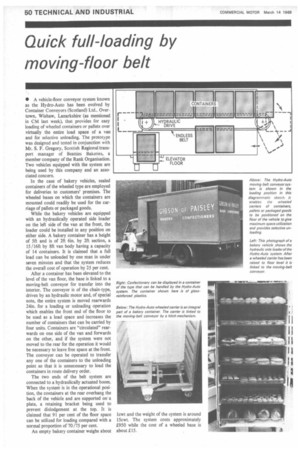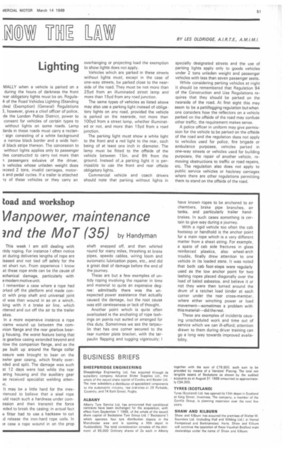Quick full-loading by moving-floor belt
Page 52

Page 53

If you've noticed an error in this article please click here to report it so we can fix it.
• A vehicle-floor conveyor system known as the Hydro-Auto has been evolved by Container Conveyors (Scotland) Ltd.. Overtown, Wishaw, Lanarkshire (as mentioned in CM last week), that provides for easy loading of wheeled containers or pallets over virtually the entire load space of a van and for selective unloading. The prototype was designed and tested in conjunction with Mr. S. F. Gregory, Scottish Regional transport manager of Beanies Bakeries, a member company of the Rank Organisation. Two vehicles equipped with the system are being used by this company and an associated concern.
In the case of bakery vehicles, sealed containers of the wheeled type are employed for deliveries to customers' premises. The wheeled bases on which the containers are mounted could readily be used for the carriage of pallets or packaged goods.
While the bakery vehicles are equipped with an hydraulically operated side loader on the left side of the van at the front, the loader could he installed in any position on either side. A bakery container has a height of 5ft and is of 2ft 6in. by 2ft section, a 15 /16ft by 8ft van body having a capacity of 14 containers. It is claimed that a full load can be unloaded by one man in under seven minutes and that the system reduces the overall cost of operation by 25 per cent.
After a container has been elevated to the level of the van floor, the base is linked to a moving-belt conveyor for transfer into the interior. The conveyor is of the chain-type, driven by an hydraulic motor and, of special note, the entire system is moved rearwards 24in. for a loading or unloading operation which enables the front end of the floor to be used as a load space and increases the number of containers that can be carried by four units. Containers arc "circulated" rearwards on one side of the van and forwards on the other, and if the system were not moved to the rear for the operation it would be necessary to leave free space at the front. The conveyor can be operated to transfer any one of the containers to the unloading point so that it is unnecessary to load the containers in route delivery order.
The two ends of the belt system are connected to a hydraulically actuated boom. When the system is in the operational position, the containers at the rear overhang the back of the vehicle and are supported on a plate, a retaining bracket being used to prevent dislodgement at the top. It is claimed that 91 per cent of the floor space can be utilized for loading compared with a normal proportion of 70 /75 per cent.
An empty bakery container weighs about
MALLY when a vehicle is parked on a during the hours. of darkness the front .ear obligatory lights must be on. Regula4 of the Road Vehicles Lighting (Standing des) (Exemption) (General) Regulations 3, however, gives a chief officer of police, de the London Police District, power to consent for vehicles of certain types to without lights on some roads. Lamp Jards in these roads must carry a rectan
• sign consisting of a white background a narrow black border and a wide horial black stripe thereon. The concession to without lights applies only to passenger :les constructed to carry not more than ri passengers exlusive of the driver, 's vehicles whose unladen weight does :xceed 2 tons, invalid carriages, motors and pedal cycles. If a trailer is attached iy of these vehicles or they carry an
overhanging or projecting load the exemption to show lights does not apply.
Vehicles which are parked in these streets without lights must, except in the case of one-way streets, be parked close to the nearside of the road. They must be not more than 25yd from an illuminated street lamp and more than 15yd from any road junction.
The same types of vehicles as listed above may also use a parking light instead of obligatory lights on any road, provided the vehicle is parked on the nearside, not more than 100yd from a street lamp, whether illuminated or not, and more than 15yd from a road junction.
The parking light must show a white light to the front and a red light to the rear, each being of at least one inch in diameter. The lamp must be fitted to the offside of the vehicle between 15in. and 6ft from the ground. Instead of ,a parking light it is permissible to use the front and rear offside obligatory lights.
Commercial vehicle and coach drivers should note that parking without lights in specially designated streets and the use of parking lights apply only to goods vehicles under 2 tons unladen weight and passenger vehicles with less than seven passenger seats.
While considering parking vehicles at night it should be remembered that Regulation 94 of the Construction and Use Regulations requires that they should be parked on the nearside of the road. At first sight this may seem to be a pettifogging regulation but when one considers how the reflectors on a vehicle parked on the offside of the road may confuse other traffic, the requirement makes sense.
A police officer in uniform may give permission for the vehicle to be parked on the offside of the road and the regulation does not apply to vehicles used for police, fire brigade or ambulance purposes, vehicles parked in one-way streets or vehicles used for building purposes, the repair of another vehicle, removing obstructions to traffic or road repairs, etc. The regulation also does not apply to public service vehicles or hackney carriages where there are other regulations permitting them to stand on the offside of the road.




















































































































